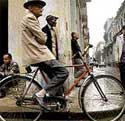 Published May 31, 2006
Published May 31, 2006by www.cicle.org
Contributed by Harv
On May 26th, the film, "The Power of Community: How Cuba Survived Peak Oil" was shown at Carlotta's Passion, an art gallery in Eagle Rock, California. Instead of how Cuba survived peak oil, this film is more about how Cuba survived the collapse of the Soviet Union and their subsequent cessation of support. It serves as a valuable lesson for us regarding life in the post carbon era. As I pointed out to the audience, the situation for the rest of the world at present is represented by the peak oil bell curve, with the upside of the curve haven taken 100 years, and the downside to zero oil will take at least another 100 years. But Cuba received a karate chop to their fossil fuel supply with the Soviet Union pulling out all support. The rest of the world could be dealing with similar severe shocks much before actual total oil depletion.Enough about that, we are interested in what Cuba did with their transportation system and their use of bicycles. Since the film was not primarily (and only poorly even secondarily) about this, I had to squint into the background of the video and listen for appropriate dialog.Cuba was never a modern consumer of automobiles. For many years they made do with cars from the 1950's and earlier, due to the embargo of imports from the U.S. since 1962. Cubans have become very clever at keeping these relics running and were thus somewhat prepared for the near total collapse of the transportation infrastructure. But not enough prepared.Enter bicycles. Did Cuba suddenly embrace a bike culture and pedal around the town and countryside smiling and waving? No they didn't. What happened was that 1.2 million bikes were imported from China and another half million were manufactured in Cuba and all were distributed to the population which now numbers 11 million. No carbon fiber 30 speed bikes here, just single speed, 50 pound steel clunkers. Cubans grudgingly swung a leg over these transportation devices, sitting upright and slowly pedaling their way over dusty and bumpy roads alongside the make-shift buses and oxen drawn carts. I did notice, however, a significant number of three-wheel multi-passenger pedicab type devices. At least as many of these as two-wheelers were shown in the urban scenes of the film.Bicycling was looked upon as a necessary chore for Cubans. Not something they took to with enthusiasm. Rough dirt roads, long distances with heat and humidity did nothing to enamor Cubans of their bikes. Health benefits were mentioned as a side effect of bicycling and the diet changes which came with the development of the new organic farming lifestyle born of necessesity. Urban bicycling in Cuba is nothing like that of China, the Netherlands, or even that of the U.S.But the lesson is learned. People will do what they have to do in the event of a real emergency. Cuba has been the world's laboratory for this. We have only to observe and project ourselves into the situation, even though our situation is, and will be, very much different than theirs. We will go through many mini-crises, ups and downs, interruptions of supply, and unfortunately long and expensive wars. We probably will not have a sudden catastrophic blow to our fossil fuel supply as Cuba did. We can survive what is coming. Like the Boy Scout motto advises, we can 'Be Prepared'. Unfortunatey our government cannot be part of the solution while it is still part of the problem. Our government and general population in the U.S. will continue to be only reactionary while we(alternate transportation advocates, permaculturists, environmentalists, etc) are proactionary. Our only hope is to expand the pool of preparedness by undergoing lifestyle changes. Many of us are already well into this process.
1 comment:
Quite sage, cher Ed. That was a fascinating piece.
Echoing your own dusky peradventure, N and i ventured out for another eight miles last night: quite sublime.
Post a Comment